|
Chapter 2
CHILE - BOLIVIA
Arica - Putre - La Paz
We
returned to the town and bought little bits of food, tangerines,
peanuts, celery, some Rinso (washing powder) and a couple of plugs (it
was difficult to do any washing without a plug and we didnít know the
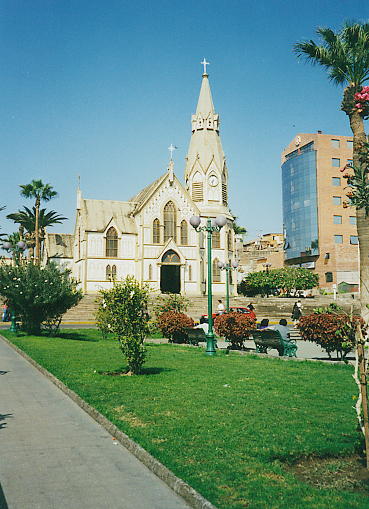 right size). Jen was
getting worried about proper washing.
right size). Jen was
getting worried about proper washing.
Back
at Venecia two Dutch people had arrived from Peru. They were spending 9 weeks in Ecuador, Peru, Chile and
Bolivia. I think they only
had a couple of days in Chile. They
were horrified by the prices because Chile is very expensive compared to
Peru. We discussed our
experiences as travellers do.
In
the evening we went to a little restaurant near the centre of town with
three plates for P1000 (£1.43). Salad
(chopped raw cabbage, tomato, beetroot and potato salad) followed by
cazuela de ave (thin soup with chicken bones) followed by pollo piquante
(a sort of chicken curry with rice).
It was a very unassuming place with very good food.
Jen had something else which consisted of beans, spaghetti,
vegetables and goodness knows what.
Friday
3 July
A
collectivo picked us up at 0745 as arranged.
It was an ordinary taxi which collected as many people as could
fit safely in the car. We
drove out of town and gained a young girl with her baby, who later left
us 30 km out of Putre at a cafe in the middle of nowhere.
We went west and then north into the topmost part of Chile.
The dirt track road wound around the bare yet impressive
mountains. The book said
the trip took 4 hours in the bus but for us it was only 2Ĺ hours.
At
Putre the collectivo driver recommended Rosamel, which was also
recommended in our book. No-one
else was staying there so we had a room with 2 sets of bunks - soon
covered in stuff - and a bathroom with 2 loos, 2 basins and 3 showers
(hot).
Jen
and I went for a walk up the valley and had to keep stopping as we were
now at 3500m but this was not a problem and was a good excuse to look at
the scenery, at the terraced hillsides growing alfalfa and oregano, the
animal herders with their horses and alpacas in corrals.
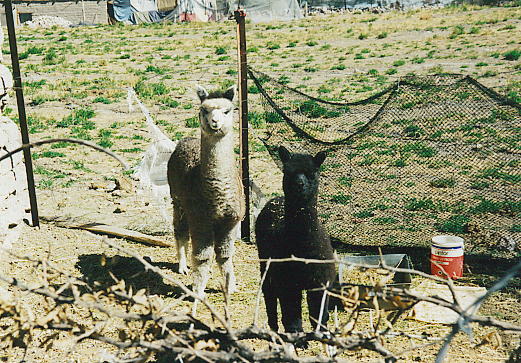
They
rushed over to look at me when I approached with my camera
There
were snowy mountains in the distance.
We were following what seemed like a dry river bed.
After several hours Jen wanted to continue so I took another
river bed home. This was
much steeper and narrower than before with bushes overgrowing the path.
I couldnít see the village.
The river bed went on and on.
Was I going the right way? I
had to leap from rock to rock. A
couple of times it was a bit hairy as I had to climb down rather than
just jumping and sometimes it was dark with caves and bones and all that
conjured up. I was getting
a little concerned that I might reach a part where I could not climb
down and would have had to go all the way back up the valley when I
turned a corner and there was a chap and his wife tending their sheep.
I had reached the village. The
mayor was chatting to someone at the first house.
The
mayor ran Rosamel and was not the mayor at all really.
When we first arrived we changed some dollars at the bank and
were amazed to see they had a television showing football behind the
counter. The armed guard
(every bank has one, even in this tiny village) served us and whilst we
were waiting the mayor came in, hopped the other side of the counter and
used the phone. When we
mentioned going to Bolivia by bus, he rushed down to Entel (the public
phone booth) and rang the bus company to get them to stop on the main
road for us and then arranged with our taxi driver to take us to the
road, probably a good half hourís walk away.
The Bolivian bus passes by on Tuesday mornings.
The mayor seemed to be everywhere, organising everything.
Jen
returned from her walk and we were sitting in our room playing cards
when one of the girls from Rosamel turned up.
She appeared to be asking if we were eating there that night.
So far in Chile they worked on Spanish time and ate late and we
have had to train ourselves not to want dinner at 1800.
Here it was different. The
mayor wanted us to eat as early as possible.
Beef cazuela (thin soup with beef bones) followed by guatita con
patas piquante (curried tripe, other chewy bits and something else
unidentifiable that looked like skin).
She could have been asking us if we liked tripe!
We went home to bed at 2030.
There was no heating and it was too cold to stay up.
Saturday
4 July
After
desayuno (breakfast) we headed for the thermal baths but the directions
were hopeless (as usual) so although we walked for miles we didnít
find them. We followed an
animal track which met a road so we followed the road thinking this must
be right. I think we must have been halfway to Bolivia by the time we
turned back. Returning to
Putre we kept on the road and found a little turn off with a Chevrolet
pickup next to a field of cows and a couple milking them.
Their dog noticed us and the chap came over. He explained we should have gone up the main road where there
was a sign off to the right, to the baths.
He shook our hands and kissed us and Jen and I both wanted to
take him home for tea (or something).
When
we returned to Putre we stopped off at ďBirding Alto AndinoĒ where
we met Barbara the Alaskan ornithologist.
She did trips to Lauca, 4 hours for P45000 (£64.28) and 8 hours
for P60000 (£85.71). Were we regretting turning down the P10000 one?
We went for a beer and sat in the sun to discuss.
Whilst outside the cafe the police arrived and chatted to the
owner. She produced a
napkin and taped it around my beer can.
Presumably they do not allow alcohol on the streets.
We decided to take the 4 hour trip.
Dinner
that night was vicuŮa steak and spaghetti.
VicuŮa is a cross between venison and beef with a touch of liver
- very rich. We couldnít
eat it all and I took the remains home for the puppy that lived in the
street outside. I also
tried the coca tea which is supposed to be very good for oneís
digestion. It tasted
vaguely herbal, vaguely grassy and was nothing to write home about (I
didnít, did I?). We had a
walk around the town before bed because the school children were
supposed to be doing something but apart from a few playing football in
the main square we didnít find anyone doing anything.
This was Putre at 2030!
Sunday
5 July
Whilst
we were getting ready to go out the Mayor turned up with two more
English people. Jen and I
suggested a birding trip to them to save us all money and we all trooped
to Barbaraís to make some arrangements.
We left Rachel and Steven discussing the trip with Barbara,
bought some lunch and headed off for the cave paintings following
Barbaraís map.
The
map showed we had to walk down past the military base, over the stream,
up round the other military base, past a field and a round thing (Jen
couldnít remember what that was supposed to signify).
At the four fields we should take the middle path.
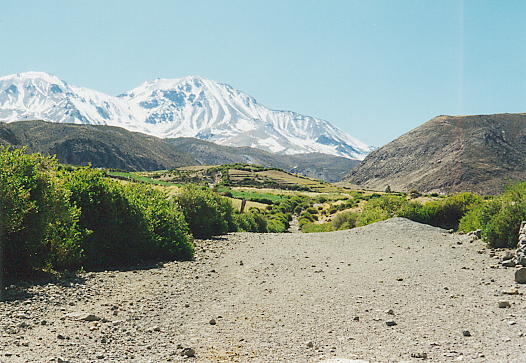
The
middle path
We
took a path between fields which disappeared into the distance and
became narrower and stonier. There
seemed no way over the edge so we retraced our steps and took the path
behind the military base. Nothing
looked right over there so on the way home, we called in at the military
base. It looked deserted.
But then we could hear music.
Jen looked through a window to see two machine guns on the floor
surrounded by cans and mess. A
soldier appeared and directed us back where we came from.
We
wandered back that way to have another look, unwilling to give up so
easily, and met a Chilean chap and his wife driving back. They attempted to explain and ended up turning round and
driving us back down the incredibly stony path (to where weíd given up
before) until they could go no further and then pointing.
We would never have thought of going down there.
We clambered down the cliff, walked over the stream, up the other
side and round the mountain on tiny paths (where someone rode his horse
and herded his cattle!). Eventually
we came to the two casas (houses) shown on the map and the 2000 BC cave
paintings of vicuŮas and people. They
were quite small and difficult to see from the path and pockmarked up
close but it was still quite amazing to think they had been there all
that time.
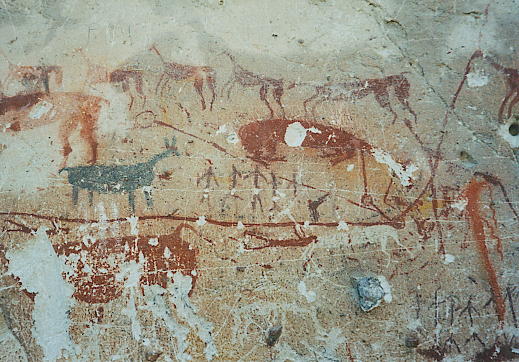
We
took the long road home - 2ľ hours and up hill at 3500m.
Aching calf muscles joined the aching thigh muscles from
yesterday. Burnt calves
joined the burnt arms and neck. The
sun and the cool wind were so deceptive - until I returned home to see
the red bits.
Rachel
and Steven wanted to have an 8 hour trek so we agreed and paid Barbara
P17500 (£25.00) each for the next day.
Barbara had a fire in her sitting room together with a breeding
budgie and a lonely lovebird. Pity
Rosamel restaurant didnít run to a fire but I got the impression one
was supposed to eat there and then push off.
The mayor had better things to do than sit around all night to
serve a beer or two to the gringos.
He had to plan his new hotel.
He had apparently got Government aid to build a huge modern hotel
in Putre. We were shown
pictures of the model he had made to get the grant.
Monday
6 July
Barbara
and Orios collected the happy quartet at 0800.
Rachel and Steven were returning to Arica that day so I
wouldnít be forced to listen to her whining for another night through
the hole in the wall by my bed. It
was not so much what she said but she had a very whiny (whiney?) voice.
First of all we spotted some guanaca which were the same colour
but had longer faces and were bigger than vicuŮa.
Then we saw the viscachas. They
were a bit like a rabbit but with a long tail.
They were part of the chinchilla family and bounded up the hill
away from us. A little
further on they were sunning themselves on the rocks at the side of the
road and refused to move. Everywhere
you looked there were vicuŮas, llamas and alpacas wandering across the
plain.
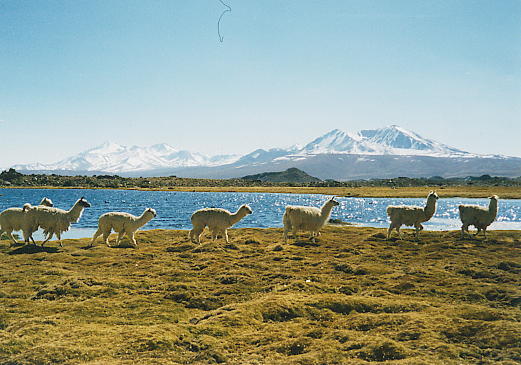
On
Lago Chungara (4600m) there were James flamingoes, black ibis, geese,
ducks, Andean gulls and many more.
On down the road to the Bolivian border there were Chilesi
flamingoes and perhaps an Andean one.
It was handy having an ornithologist with us!
It would have been very peaceful by the lake but for the main
road with lorries thundering through, to and from Bolivia.
And it was Monday - the quiet day.
We
drove through the little lagunas to the village of Parinacota (4392m) at
the foot of the Payachatas volcano.
Some of the lagunas had dried up because the water had been
diverted into channels for use further down the country - like Putre and
Arica - and Barbara was worried about the loss of habitat for the
flamingoes. Orios, our
driver, was chewing coca leaves all the time.
Jen wandered off to have her lunch by the lake at Parinacota and
was nearly left behind.
On
the return journey the minibus detoured to the Jurasi Thermal Springs to
drop Jen and I off. The
locals keep taking down the signs to stop people going there.
There was no sign on the way up from Putre but one on the way
down. We would probably not
have found it until weíd given up and started back.
The ďthermaĒ consisted of a number of pipes and two pools in
a corrugated iron shed. One
pool had a little water so Jen connected the pipes and put some more
water in. I wandered downstream to see about the ďnaturalĒ pool
which didnít seem to be there. When
I returned Jen had removed all her clothes and was in. It was very hot. In
view of my burnt bits I waited for it to cool down a little.
The room was dusty but the pool seemed OK, with no smell.
We spent some time soaking in the pool and had just decided to
get out when three soldiers walked in.
Surprise! They retreated outside whilst we dressed and then came in,
emptied the pool and brushed it out.
We left them refilling. On
the way out I noticed the natural pool on the other side of the hut.
The
mayor told us it would take 1ľ hours to walk to the springs and it took
us 2 hours to walk back - mostly downhill!
We checked in with Barbara so she knew we had made it.
The mayor had been fretting because Rachel and Steven ran off
with his keys and we were missing.
Tuesday
7 July
I
hadnít seen the puppy since I gave it some of the vicuŮa so I had to
throw the rest away. I
hoped I hadnít poisoned it. No
taxis had arrived in Putre that morning so the mayor (of course!)
arranged with one of the council chaps to give us a lift.
At the bus stop on the main road there were two policemen who
were stopping and searching trucks coming from Bolivia.
They also very kindly stopped our bus for us.
The fare was P12000 (£17.14) for both of us to La Paz and the
ticket came in two parts so one chap could sell it to us and another
chap could come along later and remove and keep one part.
We were carried back through Lauca still spotting vicuŮas,
llamas and flamingoes.
At
the Chilean border crossing we all had to line up in accordance with the
bus driverís list. Every
bus had a list, even if we werenít crossing borders - name, age,
passport number, country of origin, nationality.
By the end I should have known my passport number by heart but I
didnít and rather than keep removing it from beneath my clothing I
would write down any old number. Just
as well we never had an accident! Jen
had to explain why her passport number was different to her entry card.
They could pronounce her name but gave up on mine.
We drove across lots of no mans land to the Bolivian control
where we were automatically given seven day visas.
Back
at the bus passengers were buying lunch from an old lady who came onto
the bus with bowls, pots, packets and bags and her two daughters who
delivered food, collected empties and money.
It appeared to be cold yellow bean stew with dried potatoes.
Other people had cooked salad potatoes, which they peeled, and
strips of dried meat. The
two daughters stayed at the control but mother came with us on the bus.
Perhaps she was going home for more supplies?
She was wearing a dress in brightly coloured, shiny material with
a layered skirt, topped by a voluminous apron and the ubiquitous,
slightly battered in this case, brown bowler hat.
Her daughters were in jeans and jumpers although we did see young
women wearing the traditional dress.
The
countryside in this part of Bolivia was less severe, still dry and
scrubby but with smaller hills and more greenery.
After a while we were crossing a giant plain with tilled fields,
llamas, donkeys and sheep, all with people looking after them, on either
side. We saw lots of
deserted villages made of mud brick, some with churches, and even more
lived in villages. In the
country the houses were quite spread out and then you passed a village
with blocks of houses, crammed next to each other, and 2 or 3 two storey
Western type buildings.

Another
postcard - altiplano in Bolivia
The
road was very straight and the bus was quite comfortable for a change.
The women sat and knitted or span whilst minding the flocks and
the children were out there helping.
At
the outskirts of La Paz we passed a military camp with amazing round
houses, the double ones we presumed were the married quarters, it looked
like something from a fairy tale. We
were inhibited about taking a photo because it was a military camp and
didnít fancy being marched off the bus and locked up.
We
turned off the metalled road and drove on past lots of broken down
houses, shops selling car parts, even a few tents made of plastic.
Most of the Bolivians alighted at various points along the dirt
track. Jen was worried at
the sight of what she thought was La Paz. Then we went through a toll gate and there below us in the
valley (and up all the sides) was a huge city.
The
bus stopped at the (closed) railway station - the end of the line
literally. The railway (Arica
to La Paz) had recently been privatised and had suffered some damage
from landslides. There was
currently no money to repair it and the buses had taken all its trade.
It was hoped that it would re-open but there was some worry that
the customers would not come back from the buses which were cheaper.
It
was now gone 1700. We had
no idea where we were, neither of our books gave any information on
Bolivia, and we had 11 bolivianos (P1000 or £1.43) between us, part of
the change from the bus driver. There
was a hotel opposite, the Hotel Bolivia, who charged 44 bolivianos (£5.70)
for the two of us. Not
being ones to walk very far with our packs we stayed there, fortunately
we didnít have to pay until morning.
We set off down the hill to find a cambio and dinner.
The streets were alive with people, traffic, lights.
The stalls sold everything from disposable nappies to sweets,
from woolly gloves to soap, there were music shops one after the other,
all blaring music, and huge piles of lovely looking bread.
All the cambios and banks were closed.
In a covered market area there were fruit, juice and soft drink
stalls with cafes in the middle. We
chose one where there were lots of other people - rice, veggies,
hamburger or fish - we passed on the soup that looked like dirty
dishwater. We had to
negotiate for our dinner but that was all the Bolivian money we had so
we were in a very strong position!
We walked back up the hill to the hotel, you could tell you were
still at altitude here, past all the ladies of the night and one that
appeared to be a transvestite.
Wednesday
8 July
I
failed to get the shower to issue any hot water so I checked with madam
I was using it correctly. It
seemed to be my duty in life to harass hotel managers about hot showers.
She managed to get slightly warm water in the menís bathroom so
I showered there.
On
the way to the cambio Jen used our last boliviano to buy a llaucha -
pastry or bread (it was very difficult to tell) around a very watery
cheese sauce - awful. There
werenít half so many stalls in the daylight although it was early.
Eventually I was served in the cambio - they all took fright at
my travellers cheques. I
was offered 5.52B to $1. We
calculated a boliviano was approximately 11p.
We
found a travel agent, the girl spoke English and telephoned to book our
bus to Puno tomorrow. The
bus fare was 143.6B or $26 (£16ish).
The bus would collect us from the hotel at 0715.
One touristy shop had postcards as well as beautiful alpaca
jumpers at $90+. We were
quite tempted by the skeins of wool but would have had to carry them
around with us. Having purchased stamps at the Correos (the post office) we
discovered several little shops in another part of the same building
selling postcards, cards, posters and beautiful painted notelets.
The
Tourist Office had supplied us with a map of La Paz but with only one
day there was not much we could do apart from look at the city. The Palacio de Gobierno (government), Palacio Legislativo
(law), the Prefectura Departamenta (police) and the Cathedral were all
around Plaza Murillo - very impressive buildings.
Jen wanted to be photographed with one of the young guards which
was allowed, but couldnít decide which one.
This made them smile.
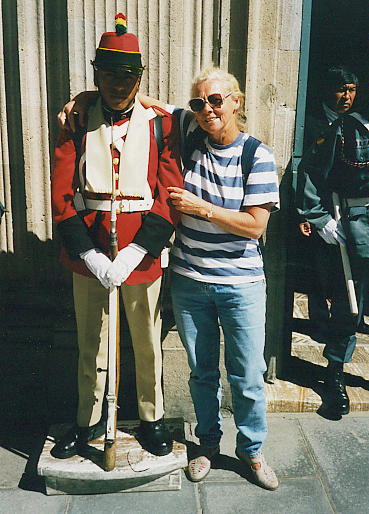
Heíd
stopped smiling by now!
We
stood briefly outside a hotel restaurant and some Americans came out and
recommended the place for lunch. Veggie
soup which was awesome apparently, salad with raw carrot at last
(usually they used cooked carrot in salads) and juice followed by
goodness knows what. White
bits that seemed like some sort of grain, grey hard potatoes, brown
chewy bits that might have been something in batter, all rather cool
with a hot mildly spicy sauce. Yummo
- I didnít think so!
Jen
and I returned to the hotel to get booted.
The standard rate for boot cleaning was 1B. When youíre not interested they hassle you but when you
want one you have to seek them out, boot cleaner that is. I rather like paying someone else to clean my boots!
We had a quick tour of another very ornate Cathedral, teeming
with people looking, praying, sitting - complete with luminous haloes on
the saints. The artesanal
stalls nearby were full of wall hangings we liked and bags, jumpers and
other stuff we didnít. Jen
nearly bought a noughts and crosses game but if she had it would have
been in the bag which was later stolen!
The next street was very touristy with expensive, beautiful
jumpers and lots of places to organise treks.
Chapter
3 Top of page
Home |